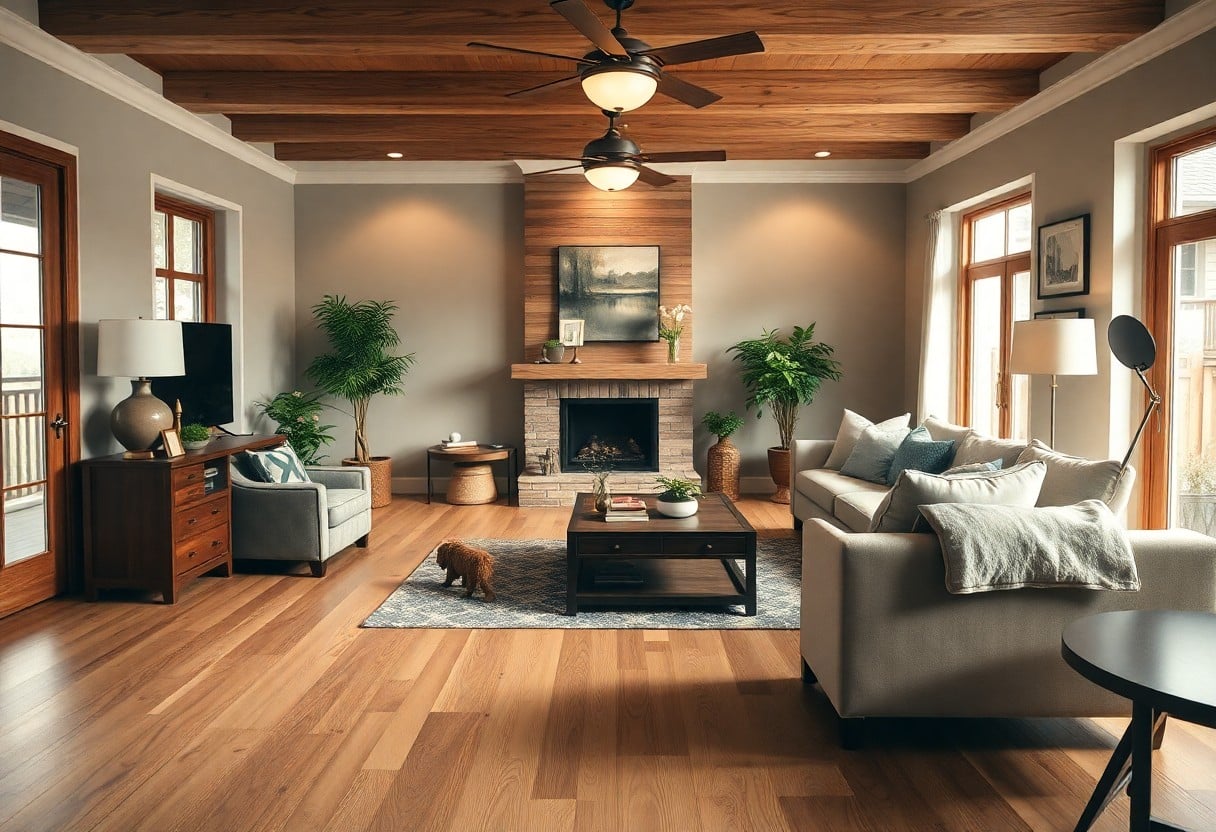Choosing the right flooring can significantly enhance the aesthetics and functionality of your home, and white oak flooring stands out as a top choice. With its stunning grain patterns and exceptional durability, it suits various design styles and lifestyles. In this ultimate guide, you will discover key factors to consider, maintenance tips, and design inspiration to help you confidently select the perfect white oak flooring for your space. Let’s explore how this timeless material can elevate your home.
Decoding the Aesthetic Appeal of White Oak
Choosing white oak flooring means embracing a timeless beauty that complements a variety of interior styles. Its natural variations in grain and color contribute to a warm, inviting atmosphere, making it a perfect choice for contemporary homes as well as rustic retreats. The robust yet elegant appearance of white oak provides versatility, allowing it to seamlessly pair with both traditional and modern furnishings. This adaptability ensures that your investment in white oak flooring will remain visually appealing for years to come.
Distinctive Grain Patterns: Nature’s Artwork
Each plank of white oak boasts unique grain patterns that reflect the tree’s history and growth. The intricate lines and swirls create an organic, artistic feel that adds depth and character to your space. As light interacts with the wood, the patterns are further accentuated, showcasing nature’s craftsmanship. This individuality will make your flooring distinct to your home, ensuring that no two spaces look alike.
Color Variations: From Pale Beige to Rich Honey
The color spectrum of white oak flooring ranges widely, with shades from pale beige to deep, rich honey. This range allows you to choose the perfect hue to match your desired aesthetic, whether you prefer a lighter, airy feel or a darker, cozier foundation. Due to its natural ability to take stains well, you can also customize the color to fit your personal style, making white oak a versatile option for any interior design.
For example, if you opt for a soft, pale beige, it can create a bright and open feeling in smaller spaces, making them appear larger and more inviting. On the other hand, embracing the deep honey hues can ground a room, adding warmth and a sense of luxury. The ability to manipulate the hue through finishes means your white oak flooring can evolve with your tastes or adapt to seasonal changes, offering endless possibilities for interior design. With a range of stains and finishes available, you can easily achieve your desired look while still benefiting from the inherent beauty of the timber itself.

The Durability Factor: Why White Oak Stands Out
With its remarkable durability and resilience, white oak is a premier choice for flooring in high-traffic areas of your home. Known for its hardiness and strength, this hardwood can withstand the rigors of daily use while maintaining its elegance. Whether you’re concerned about pets or children, investing in white oak flooring equips your space with a long-lasting beauty that can endure the test of time without compromising style.
Hardness Rating: A Championship Player in Flooring
White oak boasts an impressive Janka hardness rating of approximately 1,360, making it one of the toughest wood species available. This exceptional hardness means your floors are less likely to dent or scratch, maintaining their pristine appearance even in active households. Choosing white oak not only enhances your home’s aesthetic but also provides a durable foundation that can last for generations.
Resistance to Wear and Tear: Lifespan and Maintenance
The natural density of white oak contributes to its resistance to wear and tear, ensuring your floors can withstand the tests of time. With minimal maintenance, these floors allow for easy upkeep, and proper care can extend their lifespan significantly. Regular cleaning and occasional refinishing can keep your white oak flooring looking fresh and vibrant for decades, making it a practical investment for your home.
In addition to its strength, white oak floors can handle spills and stains better than many other hardwoods, thanks to their closed-grain structure. This unique feature not only provides an extra layer of protection from moisture but also minimizes the impact of daily wear and tear. Routine sweeping and mopping should suffice to keep your floors in top shape, and a protective finish adds another barrier against scratches. With white oak, you enjoy a beautiful, strong floor that marries elegance with practical longevity, saving you time and money on repairs or replacements in the long run.
The Cost Analysis: Budgeting for White Oak
Budgeting for white oak flooring requires a careful evaluation of both initial costs and long-term value. While the upfront investment can vary significantly based on factors such as quality, finish, and installation type, you can ensure you’re making a sound financial decision by understanding the nuances involved in selecting and maintaining this premium flooring option.
Pricing Breakdown: What to Expect per Square Foot
When exploring prices for white oak flooring, expect to pay between $3 to $8 per square foot, depending on the grade and finish you opt for. For instance, higher grades with limited knots and a fine grain may cost more, while engineered varieties offer a budget-friendly option that still showcases the beauty of white oak without compromising quality.
Long-Term Value vs. Initial Investment: An Economic Perspective
Investing in white oak flooring often pays dividends over time. While the upfront costs may be higher than other materials, the durability and aesthetic appeal of white oak can enhance your home’s value and reduce the need for future repairs or replacements. If well-maintained, your white oak floors could last for decades, providing a timeless foundation that withstands trends and wear.
Consider this: While spending $8 per square foot might initially seem steep compared to laminate options at around $2 per square foot, white oak’s longevity means you may avoid costly replacements every few years. Assuming laminate requires replacement every 10 years, your repeated expenses can quickly surpass the initial investment in white oak. Additionally, real wood flooring tends to yield a higher resale value, translating to potentially significant returns if you ever decide to sell your home. In essence, prioritizing white oak flooring may not only improve your daily living experience but also serve as an economic investment in your property’s future.
Eco-Friendly Choices: Sustainability and Sourcing
Opting for white oak flooring not only enhances your home aesthetically but can also align with environmentally responsible practices. Sourcing wood from sustainably managed forests ensures that you contribute to the preservation of ecosystems and biodiversity. By choosing certified products, you can rest assured that your flooring choice supports reforestation initiatives and responsible forestry practices, ultimately reducing your ecological footprint.
Forest Management Practices: Choosing Responsible Suppliers
Selecting suppliers who adhere to sustainable forest management practices is vital in ensuring the longevity of our wood resources. Look for certifications like the Forest Stewardship Council (FSC) label, which indicates that the wood has been harvested in a way that promotes ecological balance and social well-being. Your choice influences not just quality but also the health of our forests.
The Environmental Impact of White Oak Production
The production of white oak flooring has a measurable environmental impact, particularly concerning deforestation and carbon sequestration. Sustainable harvesting methods can mitigate these effects, allowing forests to continue their role in carbon absorption while supplying trees for flooring. Practices such as selective logging help maintain forest health by reducing the stress on ecosystems, ensuring that the benefits outweigh the costs.
White oak trees are remarkable contributors to their ecosystems, offering shelter and food to wildlife while helping to stabilize soil and regulate watersheds. The production of white oak flooring utilizes methods that can result in a lower carbon footprint compared to other hardwood options, especially when sourced from well-managed forests. By supporting local suppliers who practice sustainable harvesting, you not only secure quality flooring for your home but also a healthier environment for future generations. The more we invest in responsible sourcing, the greater the impact we have in preserving these vital forests.
Installation Insights: Professional Help vs. DIY
Choosing between professional installation and a DIY approach for your white oak flooring involves weighing your skills against the project’s complexity. Professionals bring expertise, ensuring precise measurements and optimal techniques, while DIY enthusiasts can save on labor costs and take pride in their handiwork. Evaluate your experience level, available time, and budget to make the right decision for your home.
Best Practices for a Flawless Finish
Achieving a flawless finish with your white oak flooring hinges on thorough preparation and attention to detail. Acclimate your boards in the installation environment for at least 48 hours to prevent warping. Use a moisture meter to check the subfloor’s moisture levels, and ensure that your tools, like a flooring nailer or saw, are suited for hardwood. Finally, apply an appropriate finish product to enhance durability and highlight the natural beauty of the wood.
Common Installation Mistakes to Avoid
Avoiding common mistakes during your flooring installation can save you time and money. Neglecting to acclimate the wood can lead to gaps or buckling, while improper measurement may result in wasted materials and uneven floors. Additionally, failing to check the moisture levels of the subfloor can create lasting issues with your white oak flooring. Lastly, overlooking the importance of expansion gaps around the perimeter can cause your boards to buckle as they expand and contract with changes in humidity.
Particularly, neglecting to acclimate your flooring can lead to severe problems like cracking and splitting after installation. It’s necessary to store your planks in the same environment they will be installed in, as this allows them to adjust to the local humidity and temperature levels. Moreover, if you skip proper measurement checks, you could miscalculate the quantity needed—leaving you short on materials or wasting excess boards. Always double-check your layout and measurements before you start cutting; precision is key. Ensuring that you account for expansion gaps is vital too; without them, the misalignment risk increases significantly, especially in fluctuating climates. Investing time in understanding these pitfalls will help you achieve a successful installation.
To wrap up
Now that you have explored the key factors in choosing white oak flooring for your home, you can confidently make an informed decision. Consider aspects such as grain patterns, finish options, and environmental impact, ensuring that the choice complements your personal style and lifestyle. By weighing these elements, you will find the perfect flooring that enhances your space while offering durability for years to come. Embrace the beauty and versatility of white oak to elevate your home’s aesthetic.

